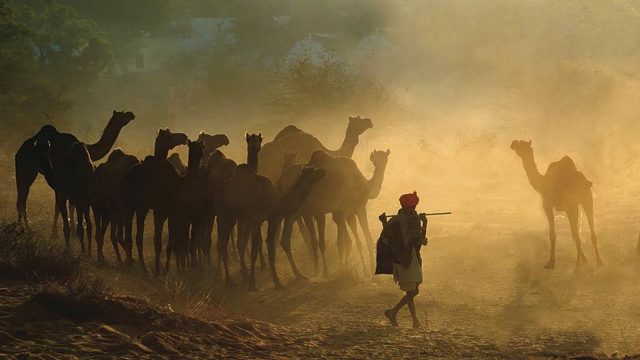Pushkar came with a lot of hype. The biggest camel fair in the world, untold lakhs of visitors, the colour, the dust, the melee… I was not going to the mela, which took place 5-13 November, but my visit would overlap the last day and some of the excitement rubbed off.
On the road, even several kilometres short of my destination, the fair made itself felt. Long trains of camels blocked traffic, bought for no doubt handsome sums of money and being led to their new homes. As we neared the town, the madness started to show. Buses, jeeps and cars roared by us, raising dust and chock-a-block with people — turbaned men sat on the roofs, adventurous lads perilously hanging on to a foothold, and only slightly more safely seated, women wearing colourful saris, ghoonghats and huge smiles, clearly having the time of their lives. Road after road into the town was shut, or converted temporarily into one-ways. As we stopped to seek new directions, now that the old ones had fallen through, we were yelled at by policemen: “Chalo, chalte raho! Hamari vyavastha kharaab hoti hai.”
Hungry, tired, grumpy and rather grimy, we reached the resort eventually. It took a vigorous wash, lunch and a cup of tea to brace us for another dive into the crowd. But we were on foot now and, as we walked to the centre, very much mainstreamed. Some parties were leaving — bearing bags of many shapes and sizes, invariably chomping on a last-minute purchase of ganna. I also found very quickly what the single most-bought item of the fair must have been: a handmade garden rake with long handle and smooth stylishly curved bamboo fingers. I also discovered what the colour of the season was for turbans—a nice striking fluorescent green.
The mela grounds were now slightly depleted, for the camel trading is most frenetic during the first three days. But dromedaries still stood tethered, as well as horses. Campfires had kettles on and men sat in the huddles so evocative of Rajasthan. A camel is judged on many parameters, I discovered. The eyes must be large, but the face small. Big teeth but small face. Long, thick neck, short tail. Small genitals. One at this fair would’ve cost on average Rs 18,000-20,000. The quality camels of Jaisalmer cost up to Rs 60,000.
Hawkers, food, milling crowds — it was a first-rate mela. But distressing too, because police loudspeakers were incessant in their announcements of missing children. One in particular came across over and over, the policeman sounding increasingly harried — an unclaimed child of three or four who’d been in the makeshift chowk for over five hours, crying, his heart fit to break.
The real action, however, was at the lake this day. The Karthik Poornima is when the moon turns into amrit and descends into the lake. In the best tradition, a dip washes your sins away. About two lakh people were there, we were told later.
The next day, the people had magically disappeared. Hung-over, bleary-eyed and anti-climaxed, Pushkar was left to clean up after the party.




